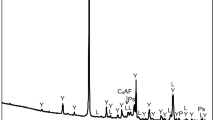Abstract
The interaction of Si anions with Al sites during the hydration process was observed by NMR, IR and SEM to understand the reaction mechanism of the hydrates formation mixed with oil shale calcined at different temperatures. As the reaction progressed, the coordination of Al (IV, V, and VI) changed almost completely to IV, when mixed with oil shale calcined at 700 °C. However, when mixed with oil shale calcined at 400 °C, some 6-coordination of Al still remained in the hydrates. Under the function of alkaline solutions, which were produced with the hydration of clinker, a certain amount of Si and Al atoms dissolved or hydrolyzed from aluminosilicate, formed geomonomers in solutions, and then polycondensed to form networks.
Similar content being viewed by others
References
Andersen M D, Jakobsen H J, Skibsted J, 2003. Incorporation of aluminium in the calcium silicate hydrate (C-S-H) of hydrated Portland cements: A high-field 27Al and 29Si MAS NMR investigation. Inorg. Chem., 42: 2 280–2 286.
Barbosa V F F, Mackensie K J D, Thaumaturgo C, 2000. Synthesis and characterisation of materials based on inorganic polymers of alumina and silica: sodium polysialate polymers. Int. J. Inorg. Mater., 2: 309–312.
Basu P, 1983. Reactions of iron minerals in sodium aluminate solutions. In: Proceedings of the 112th AIME, Annual Meeting. Atlanta: GA, Light Met., 12: 83–97.
Clayden N J, Esposito S, Aronne A, Pernice P, 1999. Solid state 27Al NMR and FTIR study of lanthanum aluminosilicate glasses. J. Non-Cryst. Solids, 258: 11–16.
Davidovits J, 1991. Geopolymers: inorganic polymeric new materials. Journal of Thermal Analysis, 37: 1 633–1 638.
Davidovits J, 1999. Chemistry of geopolymeric systems, terminology. In: Geopolymere’ 99 Proceedings. Saint-Quentin, France, 9–12.
Engelhardt G, Michel D, 1987. High-resolution solid-state NMR of silicates and zeolites, John Wiley & Sons Ltd.
FernandezJimenez A, Puertas F, 2003. Structure of calcium silicate hydrates formed in alkaline-activated slag: influence of the type of alkaline activator. J. Am. Ceram. Soc., 86: 1 389–1 395.
Hanna R A, Barrie P J, Cheeseman C R, Hills C D, Buchler P M, Perry R, 1995. Solid state 29Si and 27Al NMR and FTIR study of cement pastes containing industrial wastes and organics. Cem. Concr. Res., 25: 1 435–1 438.
Lecomte I, Henrist C, Li’egeois M, Maseri F, Rulmont A, Cloots R, 2006. (Micro)-structural comparison between geopolymers, alkali-activated slag cement and Portland cement. Journal of the European Ceramic Society, 26:3 789–3 795.
Lecomte I, Li’egeois M, Rulmont A, Cloots R, Maseri F, 2003. Synthesis and characterization of new inorganic polymeric composites based on kaolin or white clay and on ground-granulated blast furnace slag. Mater. Res., 18: 2 571–2 575.
Paspaliaris I, Karalis A, 1993. The effect of various additives on diasporic bauxite leaching by the Bayer process. Light Met., 40: 35–39.
Potgieter J H, Horne K A, Potgieter S S, Wirth W, 2002. An evaluation of the incorporation of a titanium dioxide producer’s waste material in Portland cement clinker. Mater. Lett., 1: 157–163.
Puertas F, FernandezJimenez A, BlancoVarela M T, 2004. Pore solution in alkali-activated slag cement pastes. Relation to the composition and structure of calcium silicate hydrate. Cem. Concr. Res., 34: 139–143.
Puyam S Singh, Mark Trigg, Iko Burgar, Timothy Bastow, 2005. Geopolymer formation processes at room temperature studied by 29Si and 27Al MAS NMR. Materials Science and Engineering, 26: 392–396.
Richardson I G, Brough A R, Groves G W, Dobson C M, 1994. The characterization of hardened alkali-activated blast-furnace slag pastes and the nature of the calcium silicate hydrate (C-S-H) phase. Cem. Concr. Res., 24: 813–818.
Schneider J, Cincotto M A, Panepucci H, 2001. 29Si and 27Al high resolution NMR characterization of calcium silicate hydrate phases in activated blast-furnace slag pastes. Cem. Concr. Res., 31: 993–996.
Solymar K, Sajo I, Steiner J, Zoldi J, 1992. Characteristics and separability of red mud. Light Met., 18: 209–223.
Wang S D, Scrivener K L, 2003. 29Si and 27Al NMR study of alkali activated slag. Cem. Concr. Res., 33: 769–772.
Author information
Authors and Affiliations
Corresponding author
Additional information
Supported by the National Science and Technology (2006BAE03A11); the National Natural Science Foundation of China(50674062)
Rights and permissions
About this article
Cite this article
Sun, Wb., Feng, Xp. & Zhao, Gx. Effect of distortion degree on the hydration of red mud base cementitious material. J Coal Sci Eng China 15, 88–93 (2009). https://doi.org/10.1007/s12404-009-0118-5
Received:
Published:
Issue Date:
DOI: https://doi.org/10.1007/s12404-009-0118-5




